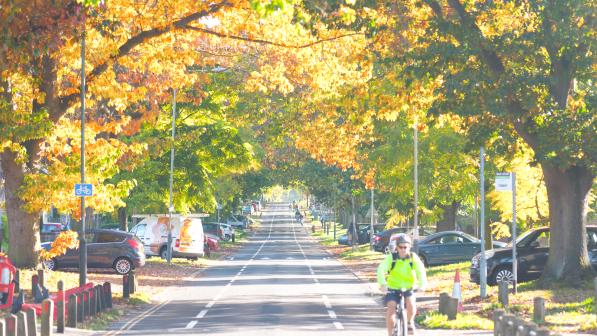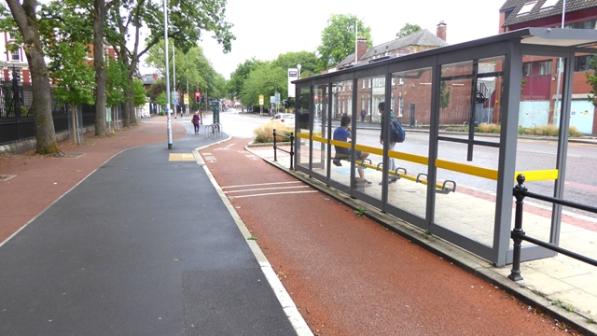Be bold if you want funding for cycling and walking infrastructure

Ask your council to be ambitious with our draft letters
When conversations about cycle lanes begin, people can quickly find themselves at cross purposes because they’re not all talking about the same thing. That’s because paint isn’t protection, so just painting a white lane on a road and calling it a cycle lane is invariably pointless, and often a waste of public money.
So, I’m talking about cycle lanes and imagining people on bikes separated from motor traffic, but my neighbour who doesn’t cycle is thinking about 40 metres of magic paint in our local town centre, while somebody at the council under pressure to do something for active travel from a limited budget is defaulting to paint rather than separation.
This lack of ambition has frustrated the introduction of separated cycle lanes for years, let alone the development of integrated networks, but there are at last indications that things might be changing.
Winners and losers in England
Last week, we briefly reported on the winners and losers from the first round of emergency active travel funding (EATF) in England.
To briefly recap, every highway authority in England was given an "indicative allocation" of funding for emergency cycling and walking interventions and had to submit their proposals for spending that money by 5 June. The Department for Transport (DfT) considered their plans, and last week confirmed which councils were going to get their indicative allocation, or more or less money in some cases.
In this question and answer piece, we outlined how councils in England could get the cash from the EATF, but in summary the money is being distributed in two phases, or "tranches". Each council was given a total indicative allocation and was able to bid for 20% of that amount in tranche 1, with the balance available in tranche 2 later in the summer.
There’s a link at the bottom of this article to a spreadsheet that sets out what each council could have received and has now been awarded, but if your council is within a combined authority (CA), for example Greater Manchester, please note that the CA has been awarded funding to allocate between various councils – though every CA has actually received 100% of their indicative allocations.
White paint and ambition
We’re highlighting the winners and losers from the EATF bids because the former have started to show some ambition. I know: one swallow doesn’t make a summer, it’s only a start, there’s much to do, and the infrastructure is not in place yet. I could go on, but 23 councils received more than they bid for because their plans were judged to be bold, including proposals to reallocate road space to people walking and cycling. That political will should be supported.
But today I’m going to focus on the losers, and I choose that word deliberately, because if you live in Blackpool, Rutland or Bedford, your council was awarded just 25% of its indicative allocation.
There’s really no other way to put it other than to say that they lost the opportunity to get government funding for active travel, because the plans submitted met neither the requirements set out by the DfT in their notification letter inviting bids, or the revised statutory guidance for highway authorities published in May.
Reallocating road space
I should clarify that we haven’t seen the details of each local authority's tranche 1 bids. The DfT hasn’t published these, and most councils who’ve received less than their indicative allocation haven’t said much about the plans they submitted. What we do know is that the DfT’s notification letter made it clear that:
- Tranche 1 funding would be released for work to begin at pace to close roads to through traffic, install segregated cycle lanes and widen pavements.
- Indicative allocations were indicative only, and to receive any money councils had to have swift and meaningful plans to reallocate road space to cyclists and pedestrians.
- The quickest and cheapest way of reallocating road space would normally be point closures, which could also be used to create low-traffic filtered neighbourhoods.
- Anything that did not meaningfully alter the status quo on the road would not be funded.
The revised statutory guidance also stated that:
- The DfT expects councils to make significant changes to their road layouts to give more space to cyclists and pedestrians.
- Councils in areas with high levels of public transport use should take measures to reallocate road space to people walking and cycling.
Without having seen individual council’s plans, the only logical conclusion is that the three who received 25%, and the 12 receiving just 50% of what they could have secured, failed to show ambition. They weren’t looking at meaningful change, or to reallocate road space.
Don’t repeat the same mistake
So, if you live in any of these authorities, your council has already lost out on 50% of the funding available to it under tranche 1:
- Essex
- Herefordshire
- Lincolnshire
- North East Lincolnshire
- North Yorkshire
- Nottinghamshire
- Oxfordshire
- Staffordshire
- Surrey
- Warwickshire
- Wokingham
- Worcestershire
If your council is listed above, ask them to be more ambitious!
We’re not listing these councils to name and shame, but rather to give people who live there an opportunity to ask their council not to make the same mistake twice, and to ensure that their bid for tranche 2 funding isn't reliant on white paint, does show ambition, and seeks to reallocate road space.
To try and nudge them along that path, we’ve written to all 15 councils who received 50% or less of their indicative allocations, outlining the expectations for funding and asking various questions concerning:
- Their plans to consider suggestions put forward by residents, and for public engagement before submitting their tranche 2 bids.
- Disclosure of their tranche 1 funding proposals.
- Their tranche 2 proposals, and whether they intend to publish those or seek stakeholder and community input.
- How their tranche 2 funding proposals will reallocate road space and meaningfully alter the status quo on the road.
How you can help
Of course, local people asking similar questions is likely to have more impact, particularly when funding available to the council has gone instead to a neighbouring council.
For example, it’s probably not that comfortable for Conservative-controlled councils in Warwickshire and Rutland to be asked why a Conservative government has given them a fraction of what they could have received, but given more to their Labour-controlled neighbouring council in Leicester. The answer of course is that Leicester was bold and ambitious and wasn’t just ordering white paint!
Over 11,000 people have already used our online action to contact their council about the need for temporary cycle lanes and other active travel interventions, with many making proposals or suggestions via the Widen My Path map. You can still use that action wherever you live in the UK, and we’ve produced a guide on how to use Widen My Path and other tools to engage with your council.
But we’ve also now tweaked that online action, so if you live in any of the 15 local authorities in England receiving 50% or less or their indicative amount, whether or not you’ve written before, you can now send an editable email to your council asking questions about their tranche 1 bid. Importantly, you can also seek assurances regarding their tranche 2 proposals and whether this time they are planning to reallocate road space as the DfT requires as a condition of funding.
We aren’t forgetting the councils who’ve shown ambition, and will be engaging with them as well in the coming weeks. But, if your local authority has squandered one funding opportunity, please take action now to make sure it doesn’t happen twice, and to move them along the path from white paint to real ambition.



